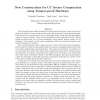Free Online Productivity Tools
i2Speak
i2Symbol
i2OCR
iTex2Img
iWeb2Print
iWeb2Shot
i2Type
iPdf2Split
iPdf2Merge
i2Bopomofo
i2Arabic
i2Style
i2Image
i2PDF
iLatex2Rtf
Sci2ools
112
Voted
EUROCRYPT
2008
Springer
2008
Springer
New Constructions for UC Secure Computation Using Tamper-Proof Hardware
The Universal Composability framework was introduced by Canetti to study the security of protocols which are concurrently executed with other protocols in a network environment. Unfortunately it was shown that in the so called plain model, a large class of functionalities cannot be securely realized. These severe impossibility results motivated the study of other models involving some sort of setup assumptions, where general positive results can be obtained. Until recently, all the setup assumptions which were proposed required some trusted third party (or parties). Katz recently proposed using a physical setup to avoid such trusted setup assumptions. In his model, the physical setup phase includes the parties exchanging tamper proof hardware tokens implementing some functionality. The tamper proof hardware is modeled so as to assume that the receiver of the token can do nothing more than observe its input/output characteristics. It is further assumed that the sender knows the program...
Related Content
| Added | 19 Oct 2010 |
| Updated | 19 Oct 2010 |
| Type | Conference |
| Year | 2008 |
| Where | EUROCRYPT |
| Authors | Nishanth Chandran, Vipul Goyal, Amit Sahai |
Comments (0)

